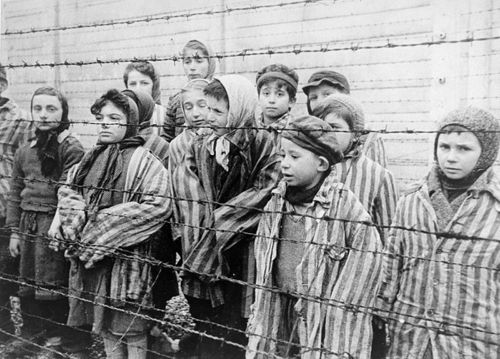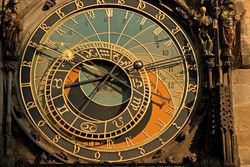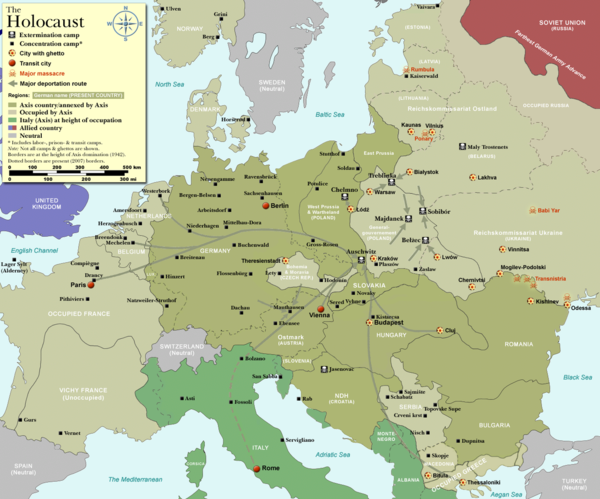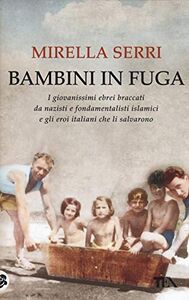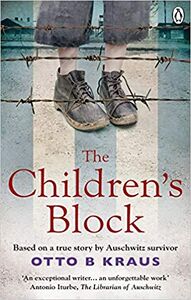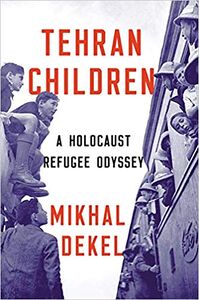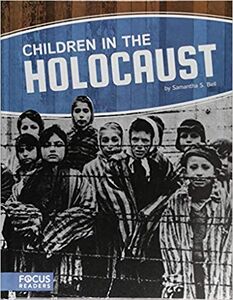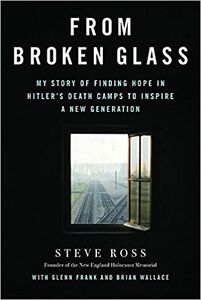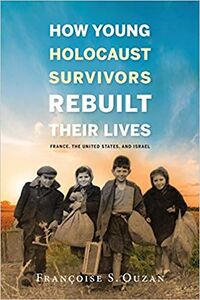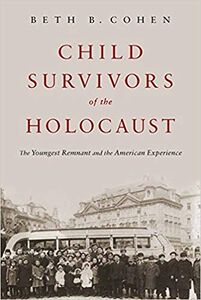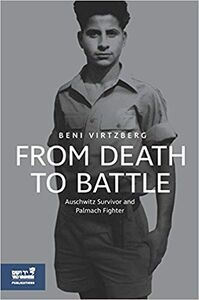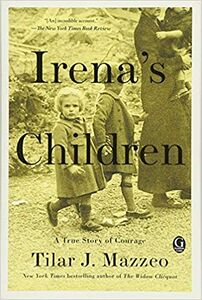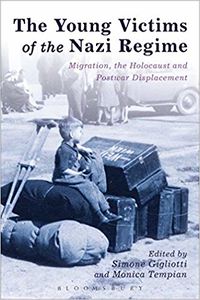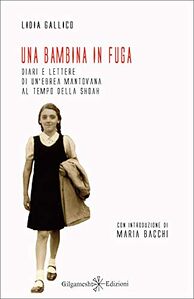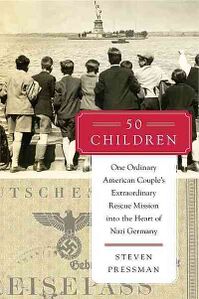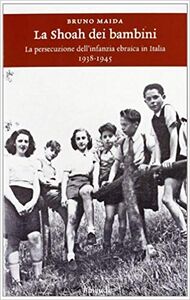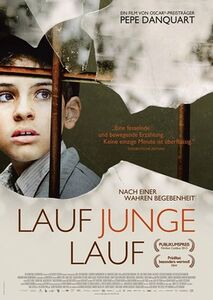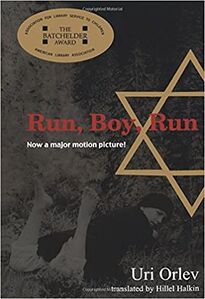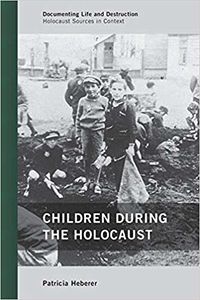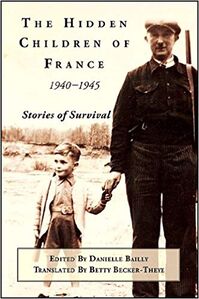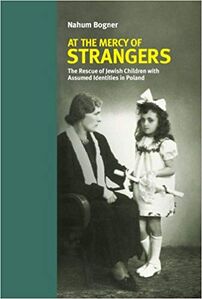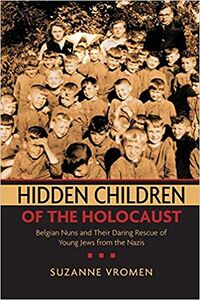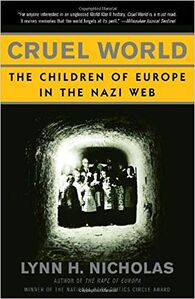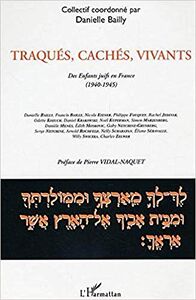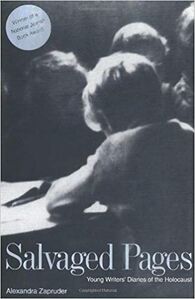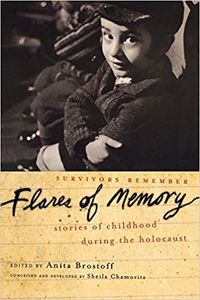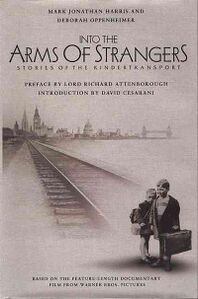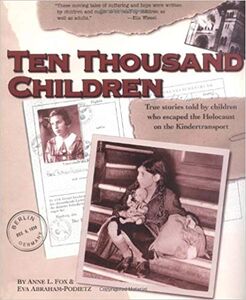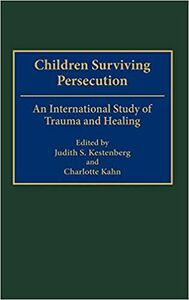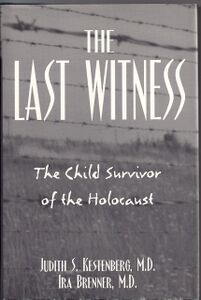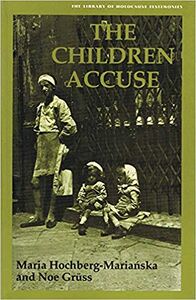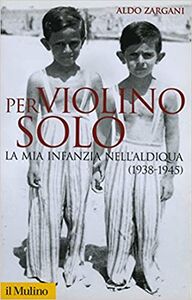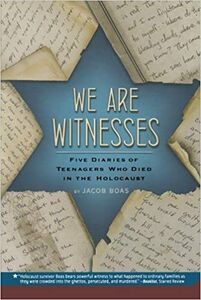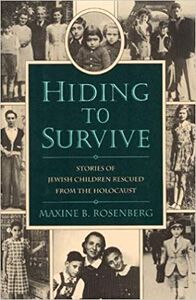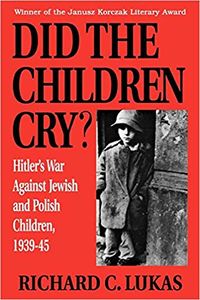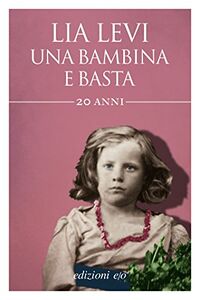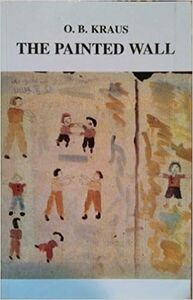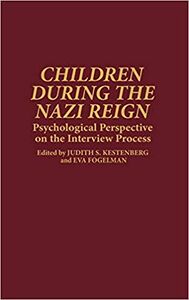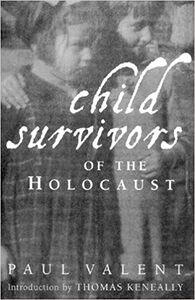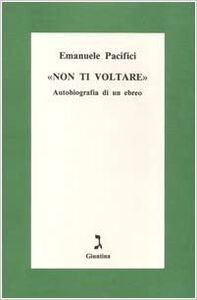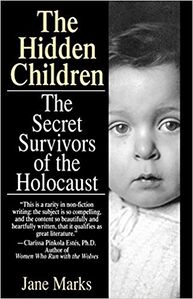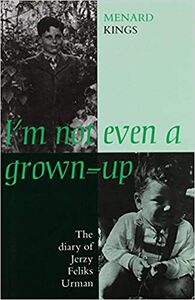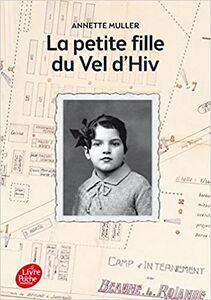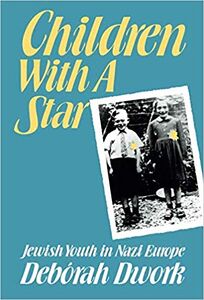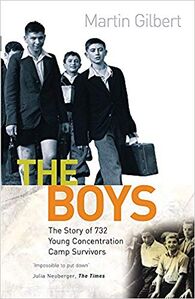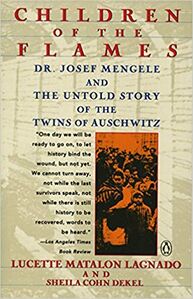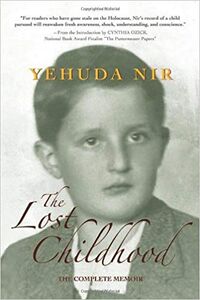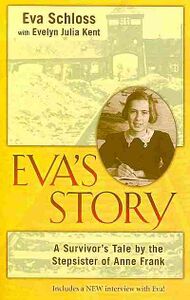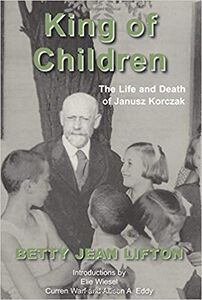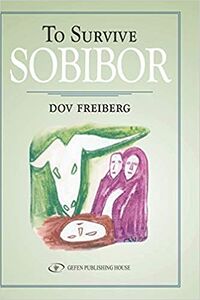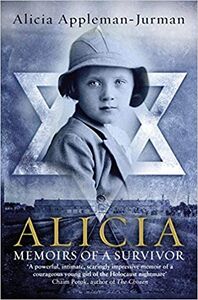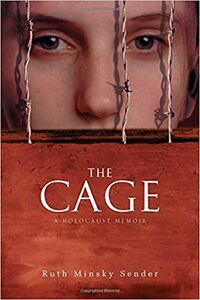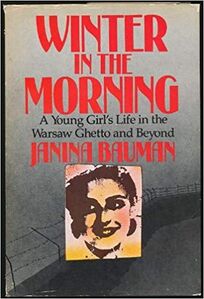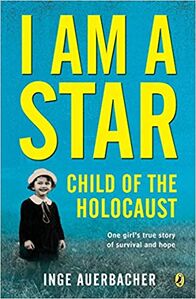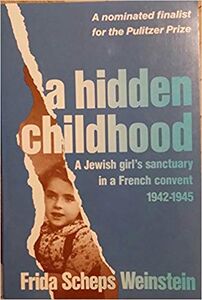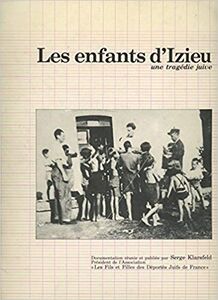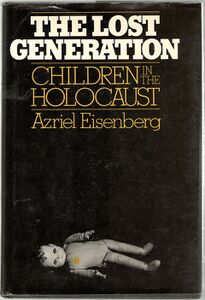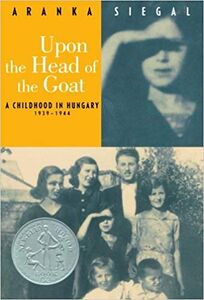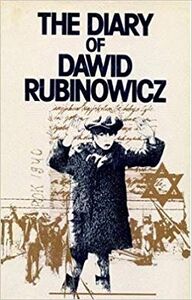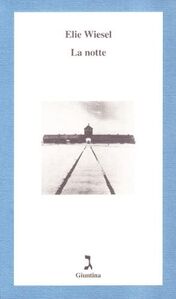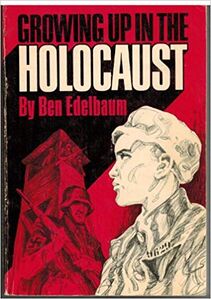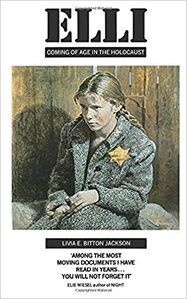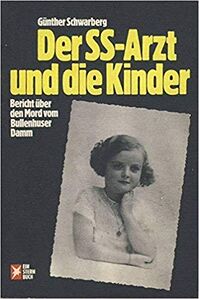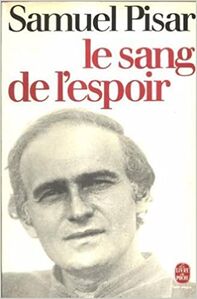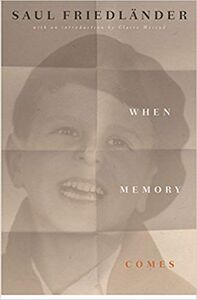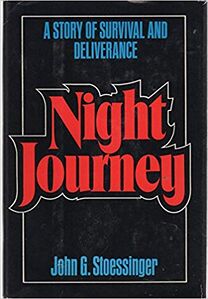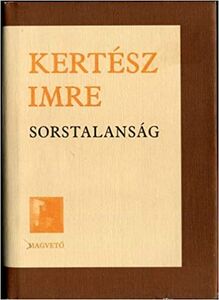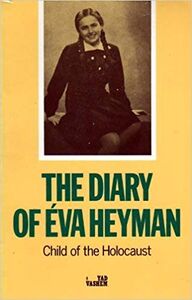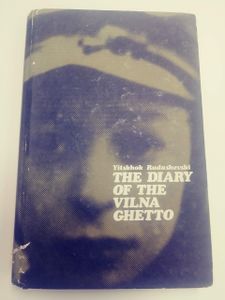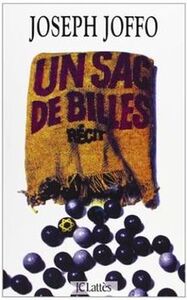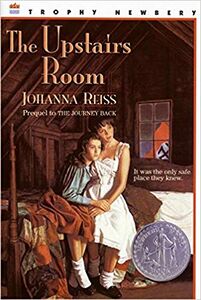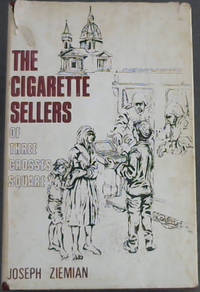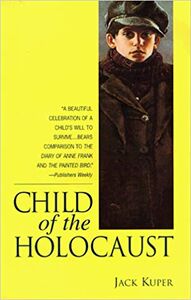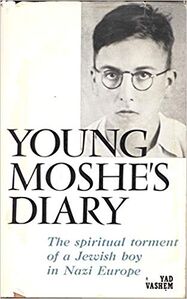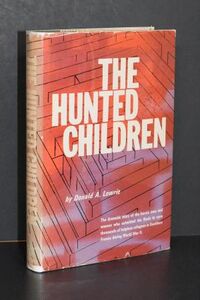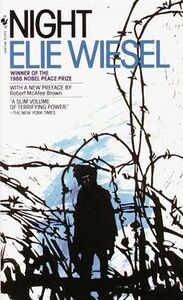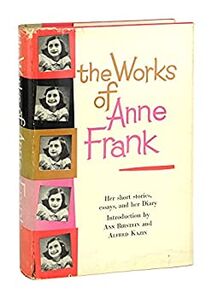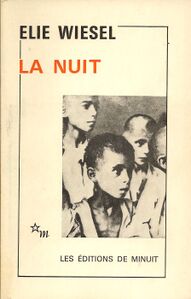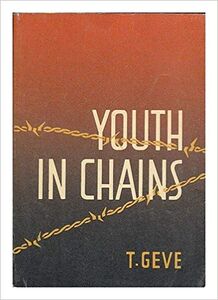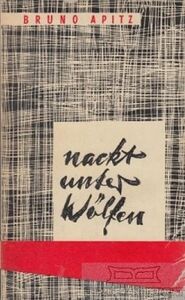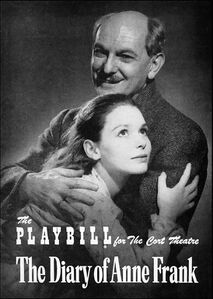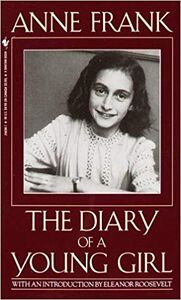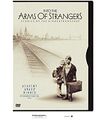Difference between revisions of "Category:Holocaust Children Studies"
(→1990s) |
(→1980s) |
||
| Line 258: | Line 258: | ||
File:1980 Bitton-Jackson.jpg|Bitton-Jackson (1980) | File:1980 Bitton-Jackson.jpg|Bitton-Jackson (1980) | ||
</gallery> | </gallery> | ||
== 1970s == | == 1970s == | ||
Revision as of 14:18, 22 March 2022
Overview
- See [[1]]
When World War II began in September 1939, there were approximately 1.6 million Jewish children living in the territories that the German armies or their allies would occupy. When the war in Europe ended in May 1945, more than 1.2 million and perhaps as many as 1.5 million Jewish children were dead, targeted victims in the Nazis’ calculated program of genocide. As Warsaw ghetto historian Emanuel Ringelblum wrote in 1942, “Even in the most barbaric times, a human spark glowed in the rudest heart, and children were spared. But the Hitlerian beast is quite different. It would devour the dearest of us, those who arouse the greatest compassion—our innocent children.”
All Jews were targeted for death, but the mortality rate for children was especially high. Only around 150,000, or 6 to 11% of Europe’s prewar Jewish population of children survived as compared with 33% of the adults. The majority of them were teenagers, between 16 and 18 years old. The younger generally were not selected for forced labor, and the Nazis often carried out “children’s actions” to reduce the number of “useless eaters” in the ghettos. In the camps, children, the elderly, and pregnant women routinely were sent to the gas chambers immediately after arrival. The older had a better chance of survival.
Liberation from Nazi tyranny brought no end to the sufferings of the few Jewish children who survived the Holocaust. Many would face the future without parents, grandparents, or siblings. Even when they were half-orphans, frequently surviving parents did not have the means or desire to care for their children.
The largest group of surviving children (60,000) was in Romania. There were 15,000 children alive in France; 12,000 in Hungary as well as in Bulgaria; 7,000 in Poland as well as in Italy; 4,000 in Belgium as well as in the Netherlands; between 2,500 and 4,500 in Czechoslovakia; 2,400 in Greece. A few thousand children survived in Concentration camps: 1,600 in Theresienstadt, 900 at Buchenwald, 500 at Bergen-Belsen, 300 at Auschwitz, etc. As many as 60,000 child survivors emigrated to the United States after the war.
Geography and Chronology of the Holocaust
(1) Racial Laws, Discrimination, Segregation (1933-38)
The first to be affected by the Holocaust were the Jewish children living in Germany. They were subjected to racial laws, discriminated, expelled from schools. Many of them left emigrated with their families.
Second came in 1938 the Jewish children living in Austria and Jewish children living in Czechia. They were subjected to the same restrictive measures as their companions in Germany. Racial laws were enacted in Italy and Hungary as well.
(2) Persecution (1938-1939 & beyond)
- Refugees -- Kindertransport -- Kraus Rescue Mission -- One Thousand Children -- Tehran Children -- Fort Ontario
Kristallnacht marked the beginning of a new, more violent stage in the persecution. In Germany, Austria and Czechia, synagogues were burned, properties were destroyed. People were arrested, intimidated, some even murdered. Emigration now became a race against time. Nearby countries (and even much far away countries, like China) became places of refuge. It was difficult however to obtain visas since many countries had strict immigration laws. Many children left alone in a Kindertransport in order to reach safety abroad.
(3) Ghettos, Hunger, Disease, Forced Labor (1939-41 & beyond)
In Sept 1939 Germany conquered Eastern Poland. Children living in Poland were immediately subjected to violent persecution, and eventually forced to live in overcrowded ghetto where thousands of them died of hunger and disease.
In May 1940, the Holocaust also hit children living in the Netherlands, Belgium and France. In occupied Western countries, Nazi authorities initially refrained from open violence in order not to provoke reactions from the local population. Racial laws were enacted and Jews were gradually deprived of any right and freedom. In occupied France and Italy, then an ally of the Germans, children of "foreign Jews" (even those born in Italy) were forced to live in internment camps.
(4) Extermination (1941-1945)
- Mass Shootings -- Death Camps -- Concentration Camps -- Hidden Children -- Street Children -- Partisans
The Operation Barbarossa marked the beginning of the most violent stage in the Holocaust. For the first time, children living in Eastern Poland, Russia, Ukraine, Belarus, Lithuania, Latvia and Estonia were directly targeted for extermination, first by specially appointed firing squads, then by deportation to death camps. By the beginning of 1942 death camps became fully operative. Jews were now deported from the Polish ghettos or from special transit camps in Western Europe directly to the gas chambers in Chelmno, Belzec, Treblinka, Sobibor, and Auschwitz. Children (especially orphans or the little ones) were the first ones to be murdered. (while only adolescents could have some chances as forced laborers).
After Sept 1943 the extermination was extended to Italy (now under German occupation) and following the German occupation of Hungary on 19 March 1944, also in Hungary.
(5) Liberation (1945)
Germany was losing the war. At the end of 1944-beginning 1945 the first concentration camps were liberated. Only a few children were found alive in Auschwitz on January 27, 1945. More consistent groups of children were liberated at Buchenwald, Berger-Belsen, Theresienstadt, Gunskirchen, ect. The end of the war also meant freedom for the thousands and thousands of children who were in hiding everywhere in Europe.
Many of the child survivors were now orphans or had been separated from their parents and relatives. Special DP camps were established for them in France, Italy (Selvino), Poland, Germany, the Netherlands...
Bibliography
2010s
- 2018 Berg.jpg
Berg (2018) repr <memoirs>
- 2017 Duguay.jpg
Duguay (2017) <film>
- 2016 German Zargani.jpg
Zargani (2016) de <@1975> <memoirs>
- 2016 Doillon.jpg
Doillon (2016) <film>
- 2015 Kadelbach.png
Kadelbach (2015) <film>
2000s
- 2007 French Zargani.jpg
Zargani (2007) fr <@1975> <memoirs>
- 2007 Berg.jpg
Berg (2007) <reprint>
- Fateless 2005.jpg
Koltai (2005) <film>
- 2004 Brenner.jpg
Brenner (2004)
- 2002 English Zargani.jpg
Zargani (2002) en <@1975> <memoirs>
1990s
- 1997 Benigni.jpg
Benigni (1997) <film>
- 1991 Durlacher.jpg
Durlacher (1991)
- 1990 Holland.jpg
Holland (1990) <film>
1980s
- 1987 Sherin.jpg
Sherin (1987) <film>
- 1987 Malle.jpg
Malle (1987) <film>
- 1985 Klarsfeld English.jpg
Klarsfeld.en (1985) [1984]
- 1984 Schwarberg English.jpg
Schwarberg.en (1984) <1979>
- 1984 Orlev.jpg
Orlev.en (1984) <1981>
- 1984 Hemmendinger.jpg
Hemmendinger (1984)
1970s
- Oberski Dutch.jpg
Oberski (1978) <memoirs>
1979
- Günther Schwarberg. Der SS-Arzt und die Kinder: Bericht über den Mord vom Bullenhuser Damm <German> (Hamburg [Germany]: Gruner und Jahr, 1979). -- English tr. by Henri Nannen. The Murders at Bullenhuser Damm: The SS Doctor and the Children (Bloomington: Indiana University Press, 1984). --- "On the night of April 20, 1945, 20 Jewish children who had been used in medical experiments at Neuengamme, their four adult caretakers and six Soviet prisoners were murdered in the basement of the school ... The twenty Jewish children (10 boys and 10 girls, age 5 to 12, from Poland, France, Italy and Slovenia) came from Auschwitz concentration camp. They were chosen by Josef Mengele and sent to Neuengamme as a "gift" to his colleague Kurt Heissmeyer, to be used as guinea pigs for experiments on tuberculosis". --- Günther Schwarberg (1926-2008) was a German journalist and author whose 1979 series of articles in German news magazine Der Stern and subsequent book "The SS Doctor and the Children" brought the World War II era war crimes committed in Neuengamme concentration camp and Bullenhuser Damm School in Hamburg to the public's conscience in Germany, and the rest of the world.
1974
- The Diary of Éva Heyman (1974) is the first English edition of a diary written by Holocaust victim Éva Heyman (1931-1944) in 1944 (age 13), while living in Hungary under Nazi rule. Published in Jerusalem: Yad Vashem, 1974. Originally published in Budapest: Uj Idok Irodalmi Intézet R.T. (Singer és Wolfner), 1948. Also published in Hebrew, Catalan, French and Italian. --- "The diary of Éva Heyman, born in 1931 in Nagyvárad, northern Transylvania (now Oradea, Romania), presented by her mother, Ágnes Zsolt. Her diary covers the period from 13 February (her 13th birthday) to 30 May 1944. At the time of the German occupation in March 1944, Éva was a student at the Jewish school. Her great-grandfather and a great-uncle had been Chief Rabbis of the Neolog Jewish community in the town in the 19th-20th centuries. Éva's parents had divorced, and her mother married the Hungarian Jewish writer Béla Zsolt, who lived in Budapest; Éva remained in Nagyvárad and was raised by her maternal grandparents, the Rácz family. In her diary, she gives a graphic description of the harsh events of the time, both in her home environment and in the city at large. When the ghetto was established in Nagyvárad, Éva's parents, who had been visiting in Nagyvárad, were also interned. They managed to escape from the ghetto to Budapest, where they were rescued on the Kasztner train. Éva, her grandparents, her biological father (Béla Heyman), his mother, as well as other family members were all deported to Auschwitz. Éva arrived in Auschwitz on 6 June, and was gassed on 17 October. Her mother presents here a very brief but heartrending description of Éva's experiences in Auschwitz. At the end, it was Mengele himself who sought her out and put her on the truck to be taken to the gas chamber. Her diary survived because she gave it to the family's cook who came to visit them in the ghetto on 30 May." --- "Presents diary entries from the last few months of a young girl’s life, from her thirteenth birthday on February 13, 1944 to May 30, 1944, just before she was deported to Auschwitz. Conveys her fears and describes daily life in a ghetto in Nagyvarad, Romania. Includes endnotes and an appendix of letters written to her mother about Eva from people close to the family" (USHMM).
1973
- The Diary of the Vilna Ghetto (1973) is a diary written by Holocaust victim Yitskhok Rudashevski (1927-1943) in the years 1941-43 (age 14-16), when living in the Vilma Ghetto. Originally published in Hebrew in 1968. --- Published in Tel Aviv [Israel]: Ghetto Fighters' House, 1973. Originally published in Hebrew (Tel Aviv: ha-Kibuts ha-meuhad, 1968). Also published in French (2016), and Lithuanian/Yiddish (2018). --- Yitskhok Rudashevski wrote a diary from June 1941 to April 1943 which detailed his life and struggles living in the Vilna ghetto. His diary was discovered by his cousin Sore Voloshin, in 1944. His cousin Voloshin fought the German army and the Soviet Union, later returning to the hideout, and found Yitskhok's diary. The diary was published in 1973 in English translation by the Ghetto Fighters' House publisher in Israel. --- "This is the diary of one of the "other Anne Franks," teen diarists of the Holocaust who are not nearly as famous as she. Yitskhok Rudashevski was fourteen when he began his diary in Vilna (Vilnius), Lithuania during the Nazi occupation. He was a gifted writer and wrote movingly of how his family and all the other Vilna Jews were confined to a ghetto and the ghetto kept shrinking and shrinking as the Nazis conducted "Aktions" and killed vast numbers of people, usually by machine-gunning them en masse at nearby Ponar. Rudashevski did not survive; he and his family went into hiding, but they were caught and almost all of them were executed. He was fifteen years old when he died. His account of the suffering of the Vilna Jews, and his own struggle to remain human amid the disaster, is well worth reading." --- "Diary of a boy who died during the liquidation of the Vilna ghetto. Records events occurring in the ghetto and his activities with Rudashevski’s school and youth club. Contains endnotes and appendixes including a testimony by the author’s cousin describing her discovery of the diary."--Holocaust Encyclopedia (USHMM). --- Yitskhok Rudashevski (1927-1943) was a young Jewish teenager who lived in the Vilna Ghetto in Lithuania during the 1940s. He was shot to death in the Ponary massacre on Oct 1, 1943 during the liquidation of September–October 1943.
1970
- Joseph Ziemian. The Cigarette Sellers of Three Crosses Square. Minneapolis: Lerner Publications Co., 1970). --- "The Cigarette Sellers of Three Crosses Square is the true account of a band of Jewish children, ages seven to sixteen, who survived the Warsaw Ghetto during the last three years of World War II (1943-1945). The author, Joseph Ziemien, finds two of the children by accident at a soup kitchen in Central Warsaw ... The astonishing, true story of a group of Jewish children who managed to escape from the Warsaw ghetto in 1942 and survive in the Aryan section of the Nazi-occupied city. Sentenced to death, hounded at every step, they kept themselves alive by peddling cigarettes in Warsaw's Three Crosses Square - where the author, a member of the Jewish Underground in Poland, met and helped them and recorded their story. Several of the children were finally caught and killed, but most survived and are alive today. The story of the cigarette sellers has been published in Polish, Romanian, Hebrew and Yiddish, and a dramatised version has been broadcast in Israel. The book was awarded a literary prize by the World Jewish Congress in New York."
1960s
- 1967 Berri.jpg
Berri (1967) <film>
- 1965b Kosinski.jpg
Kosinski (1965)
- 1963 Beyer.jpg
Film (1963)
- 1948 Lena.jpg
Küchler-Silberman (1961) en]]
- 1960 Leopold.jpg
Leopold (1960) <film>
1965
- Young Moshe's Diary: The Spiritual Torment of a Jewish Boy in Nazi Europe (1965) is the English ed. of a diary written by Holocaust victim Moshe Flinker (1926-1944) in the years 1942-1943 (age 15-17), when living in hiding in Brussels, Belgium with his family. --- "Moshe Flinker died in Auschwitz but he left copy books describing his innermost thoughts during the fateful days prior to his deportation. His surviving sisters rescued his writings from the cellar of the house in which they had all hid. In his unnatural underground existence he did not fully realize the methodical extermination being perpetrated by the Nazis, but he came very near in a remarkable portrayal of the Jewish situation, which he recorded in January 1943."--Publisher description. --- "Diary of a Belgian teenage boy who died with his parents in Auschwitz. Focuses on his strong identification with the rest of the Jewish community and his feelings of guilt for living safely with his family."--Holocaust Encyclopedia (USHMM). --- "Moshe Flinker was a sixteen-year-old Jewish boy whose family had fled from Holland to Belgium in an attempt to avoid deportation to the east. During this period of hiding and flight, Moshe was no longer able to go to school or to engage in the activities of normal life. In an attempt to stave off idleness, he decided to begin a diary. Moshe used his diary to record the experiences that his family faced in their struggle to endure Nazi persecution. He also wrestled continuously with the question of why this suffering plagued the Jewish people. On November 30, 1942 he wrote, “Now I return to the question mentioned above and its solution: what can God mean by all that is befalling us and by not preventing it from happening? This raises a further question, which must be settled before we can proceed further with the main problem. This second question is whether our distress is part of the anguish that has afflicted the Jewish people since the exile, or whether this is different than all that has occurred in the past. I incline to the second answer, for I find it very hard to believe that what we are going through today is only a mere link in a long chain of suffering.” Moshe was a deeply religious young man and he sought to understand his present circumstances in the light of biblical history. He looked for insight from the persecutions of the past and longed for God’s promised redemption of the Jewish people. He believed that this deliverance would come when the conditions were right, both in the severity of persecution and in the responses of the victims. Much of his diary was dedicated to this type of analysis. He concluded his November 30th entry with these words, “I should like to pray to the Lord of Israel that He may fulfill in the near future the prayer: ‘Return us unto thee, O Lord, and we shall return; renew our days as of old.’’--Holocaust Center of Florida. --- Published in Jerusalem [Israel]: Yad Vashem, 1965. Originally published in Hebrew (Jerusalem [Israel]: Yad Vashem, 1958). --- Also published in Russian, Dutch, German, French, Italian, and Yiddish. --- Moshe Flinker (1926-1944) was born in The Hague on October 9, 1926, and was raised in an Orthodox Jewish home. After being subjected to increasingly restrictive anti-Jewish measures following the German occupation of the Netherlands in 1940, the Flinker family fled to Belgium in 1942. In Belgium, Moshe and his family were able to pass as non-Jews with the help of false identity papers and relative anonymity ... Moshe was a deeply religious young boy who grappled with the theological problems posed by the unprecedented persecution of the Jews. He was also a gifted linguist who knew and studied eight languages, including Arabic, which he saw as fundamental to his future life in Palestine ... In April 1944, after being betrayed by a known Belgian Jewish collaborator, Moshe, his mother, and his sisters Esther Malka and Leah, were arrested at their home and deported to Malines. His father, tipped off by a neighbor, prevented Moshe’s four other siblings from going home and arranged for them to find refuge in the Tieffenbrunner orphanage near Antwerp ... Two weeks later, Moshe’s father was caught and sent to Malines, where he found his family. They were all deported to Auschwitz-Birkenau in May 1944. Moshe’s mother, Mindel, was murdered on arrival. Esther Malka and Leah remained in the women’s camp ... Moshe and his father spent several months in Auschwitz-Birkenau before they were transferred to Echterdingen labor camp, where they both contracted typhus. From there, they were sent to Bergen Belsen, where they both succumbed to typhus in January 1945 ... Esther Malka and Leah survived Auschwitz-Birkenau and were reunited with their four siblings in Brussels after the liberation. They all emigrated to Israel.
1963
- Donald A. Lowrie. The Hunted Children (New York, NY: Atheneum, 1963). --- "Of all the stories to emerge from the wretchedness that was World War Two, the most ghastly and the least believable is the record of conditions in European internment camps for refugees, political prisoners, and other ""undesirable elements,"" men, women, and children ... As chairman of the ""Nimes Committee"" for the coordination of relief work among national and international organizations both Christian and Jewish, Donald Lowrie knew as much about camp conditions as anyone who survived the war. He was in close touch with the methods of financing legal and extralegal operations, and personally fought many rounds in the battle for visas, travel permits, and special concessions that had to be wrung from a treacherous Vichy. One chapter title, ""Hiding Six Thousand Children,"" expresses the staggering task of gathering up the fragments of refugee youth (preponderantly, of course, Jewish youth), concealing them, and sustaining them until they could be spirited away or liberated at the close of hostilities."--Kirkus Review. --- Donald Alexander Lowrie (USA, 1889-1974) - As YMCA secretary served in Russian and Eastern Europe (1916-32), with his wife Helen Ogden Lowrie. Lowrie retired from the YMCA in 1932 and became the Director of the United States House at the Cité Université in Paris. The approaching world war and rising wave of refugees convinced Lowrie to return to the YMCA in 1938. He worked with Paul B. Anderson to provide American Association relief to Russian, Czech, and Bulgarian refugees in France. Lowrie remained in France until October 1942, when he relocated to Switzerland to provide YMCA services to refugees there. From 1945 to 1950, Lowrie represented the World's Committee of the World's Alliance of YMCA's in relief work for displaced persons in France.
1961
- Lena Küchler-Silberman. My Hundred Children, English ed. London: Souvenir Press; and Garden City, NY: Doubleday, 1961 @1948.
1960
- Dawid Rubinowicz (M / Poland, 1927-1942). First published in Polish (Warszawa : Ksiazka i Wiedza, 1960). English ed. The Diary of Dawid Rubinowicz (Edinburgh, Scotland: Blackwood, 1981).
1950s
- 1959 Edith Bruck.jpg
Bruck (1959) <memoirs>
1959
- Edith Bruck / Edith Steinschreiber (F / Hungary, 1932). Chi ti ama così <Italian> (Milan: Lerici, 1959). English ed.: Who Loves You Like This, trans. Thomas Kelso (Philadelphia, Pa. : Paul Dry Books, 2001).
1958
- Elie Wiesel. La nuit. Paris: 1958.
- First edition (in Hebrew) of the Diary of Moshe Flinker (M / Belgium, 1926-1944): Jerusalem [Israel]: Yad Vashem, 1958. Then published in English in 1965: Young Moshe's Diary: The Spiritual Torment of a Jewish Boy in Nazi Europe (Jerusalem [Israel]: Yad Vashem, 1965).
- Thomas Geve / Stefan Cohn (M / Germany, 1929). Youth in Chains (Jerusalem : R. Mass, 1958).
- Bruno Apitz, Naked Among Wolves (1958), inspired by the story of Stefan Jerzy Zweig (M / Poland, 1941).
1956
- Elie Wiesel (M / Romania, 1928-2016). און די וועלט האָט געשוויגן / Un di Velt Hot Geshvign ["And the World Remained Silent"] <Yiddish> (Buenos Aires: Central Union of Polish Jews in Argentina, 1956). Revised French ed. La Nuit (Paris: Les Éditions de Minuit, 1960). English ed. The Night, trans. Stella Rodway (New York: Hill & Wang; and London: MacGibbon & Kee, 1960). International bestseller. Translated in more than 20 languages.
External links
Subcategories
This category has the following 21 subcategories, out of 21 total.
- Holocaust Children Studies--1930s
- Holocaust Children Studies--1940s
- Holocaust Children Studies--1950s
- Holocaust Children Studies--1960s
- Holocaust Children Studies--1970s
- Holocaust Children Studies--1980s
- Holocaust Children Studies--1990s
- Holocaust Children Studies--2000s
- Holocaust Children Studies--2010s
- Holocaust Children Studies--2020s
*
Media in category "Holocaust Children Studies"
The following 72 files are in this category, out of 72 total.
- 1934 Bonham Carter.jpg 1,126 × 1,500; 149 KB
- 1945 Borwicz - Rost - Wulf.jpg 187 × 270; 10 KB
- 1946 Kaplan.jpg 187 × 269; 7 KB
- 1947 Grüss.jpg 188 × 268; 13 KB
- 1947 Hochberg - Grüss.jpg 128 × 184; 3 KB
- 1947 OSE.jpg 1,200 × 1,635; 355 KB
- 1947 Tenenbaum.jpg 650 × 907; 119 KB
- 1963 Lowrie.jpg 300 × 450; 23 KB
- 1979 Schwarberg.jpg 332 × 499; 32 KB
- 1982 Eisenberg.jpg 639 × 935; 131 KB
- 1984 Hemmendinger fr.jpg 345 × 499; 40 KB
- 1984 Klarsfeld.jpg 363 × 499; 32 KB
- 1984 Schwarberg en.jpg 300 × 434; 37 KB
- 1985 Klarsfeld en.jpg 185 × 260; 15 KB
- 1988 Eisen.jpg 333 × 499; 30 KB
- 1990 Lagnado.jpg 322 × 499; 38 KB
- 1991 Durlacher nl.jpg 120 × 200; 6 KB
- 1991 Dwork.jpg 339 × 499; 36 KB
- 1991 Gilbert.jpg 325 × 499; 31 KB
- 1993 Marks.jpg 322 × 499; 31 KB
- 1993 Valent.jpg 324 × 499; 30 KB
- 1994 Kestenberg.jpg 314 × 499; 18 KB
- 1994 Kraus.jpg 321 × 499; 21 KB
- 1994 Lukas.jpg 333 × 499; 40 KB
- 1994 Rosenberg.jpg 310 × 474; 31 KB
- 1994 Stein.jpg 296 × 474; 23 KB
- 1995 Boas.jpg 334 × 499; 30 KB
- 1996 Hochberg - Grüss en.jpg 326 × 499; 39 KB
- 1996 Kestenberg.jpg 429 × 640; 77 KB
- 1998 Durlacher en.jpg 292 × 499; 26 KB
- 1998 Kestenberg.jpg 314 × 499; 19 KB
- 1999 Fox.jpg 410 × 500; 36 KB
- 1999 Kustanowitz.jpg 371 × 499; 24 KB
- 2000 Harris doc.jpg 342 × 400; 17 KB
- 2000 Harris.jpg 400 × 605; 39 KB
- 2000 Hemmendinger Krell en.jpg 348 × 499; 33 KB
- 2001 Brostoff.jpg 333 × 499; 30 KB
- 2002 Zapruder.jpg 325 × 499; 20 KB
- 2004 Bailly.jpg 326 × 499; 28 KB
- 2004 Brenner de.jpg 325 × 499; 26 KB
- 2005 Nicholas.jpg 325 × 499; 33 KB
- 2006 Lee.jpg 400 × 604; 41 KB
- 2008 Vromen.jpg 333 × 499; 49 KB
- 2009 Abrams - Blaikie.jpg 375 × 499; 43 KB
- 2009 Bogner.jpg 337 × 499; 21 KB
- 2009 Brenner en.jpg 330 × 499; 29 KB
- 2010 Bailly English.jpg 332 × 499; 31 KB
- 2010 Tedesco.jpg 201 × 279; 16 KB
- 2011 Heberer.jpg 333 × 499; 32 KB
- 2012 Baumel-Schwartz.jpg 333 × 499; 33 KB
- 2012 Hodge.jpg 389 × 499; 36 KB
- 2013 Maida.jpg 316 × 499; 35 KB
- 2014 Eichengreen it.jpg 322 × 500; 39 KB
- 2014 Pressman.jpg 400 × 601; 26 KB
- 2016 Gigliotti Tempian.jpg 333 × 499; 33 KB
- 2016 Leytner.jpg 1,000 × 1,333; 115 KB
- 2016 Mazzeo.jpg 336 × 499; 43 KB
- 2016 Voigt.jpg 337 × 499; 26 KB
- 2017 Nelson.jpg 328 × 500; 31 KB
- 2018 Cohen.jpg 334 × 499; 27 KB
- 2018 Ouzan.jpg 333 × 499; 33 KB
- 2018 Strada - Spini.jpg 334 × 500; 43 KB
- 2019 Bell.jpg 388 × 499; 46 KB
- 2019 Dekel.jpg 331 × 499; 37 KB
- 2019 Kraus.jpg 318 × 499; 39 KB
- 2019 Serri.jpg 315 × 500; 27 KB
- 2019 Stańczyk.jpg 354 × 499; 28 KB
- 2020 Selmin.jpg 305 × 499; 37 KB
- 2021 Fontana.jpg 494 × 768; 94 KB
- 2021 Lang Korn Goldig.jpg 440 × 655; 32 KB
- 2021 Malaguti.jpg 355 × 500; 23 KB
- 2022 Sciapeconi.jpg 326 × 500; 22 KB
